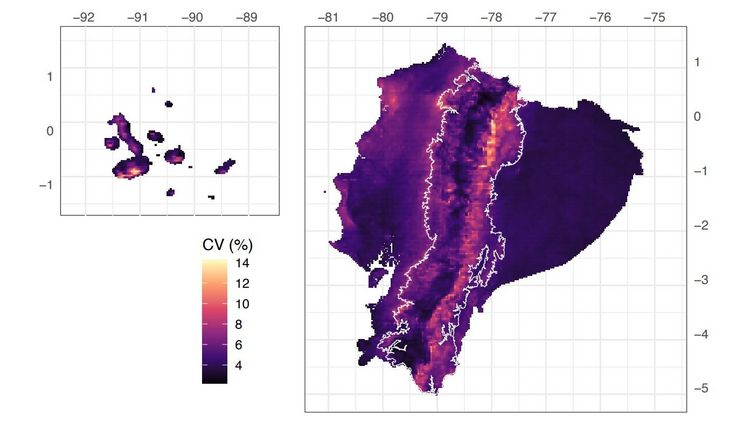Mariela Tapia (EUREC 13-14) from Ecuador together with other colleagues have published two recent papers on the analysis of the spatial and temporal variability of solar resources in Ecuador’s mainland and the Galapagos Islands. This research aims to support the optimal planning and deployment of solar power systems in Ecuador, thus contributing to a sustainable energy transition in her home country.
Spatio-temporal characterization of long-term solar resource using spatial functional data analysis: Understanding the variability and complementarity of global horizontal irradiance in Ecuador.
In this paper, we propose a methodology to characterize the spatio-temporal variability of global horizontal irradiance (GHI) at a regional scale using long-term satellite-derived data. Spatial functional data analysis (sFDA) is used to identify areas with similar intra-annual variability patterns. The methodology is applied to a 21-year period data on Ecuador retrieved from the National Solar Radiation Database. Being the first time that sFDA is used for this purpose, the results indicate that it provides an appropriate basis for the interannual variability and complementarity analyses. In Ecuador's mainland, twenty-two subregions with four seasonal patterns are identified. The highest GHI potential (5.4 kWhm−2d−1) with the lowest variability (3.4%) is found in the Inter-Andean valleys. Further, seasonal complementarities between the coast and western Andes are identified. In Galapagos, high values are found over all islands (≥4.8 kWhm−2d−1), characterized by three subregions with one seasonal pattern. Our findings provide the first comprehensive spatio-temporal characterization of GHI in Ecuador, which aims at supporting a sustainable energy transition in the country.
(Full text can be found here)
Tapia, M., Heinemann, D., Ballari, D., and Zondervan, E. (2022). Spatio-temporal characterization of long-term solar resource using spatial functional data analysis: Understanding the variability and complementarity of global horizontal irradiance in Ecuador. Renewable Energy, 189, 1176–1193. https://doi.org/10.1016/j.renene.2022.03.049
Power to the city: Assessing the rooftop solar photovoltaic potential in multiple cities of Ecuador.
In this paper, we assess the potential of rooftop solar photovoltaic in three populated cities in Ecuador’s mainland (Quito, Guayaquil and Cuenca) and in the Galapagos Islands. The assessment involves (i) the estimation of the available rooftop area based on geographic information system data, (ii) the calculation of energy yield based on hourly satellite-derived irradiance and meteorological data, and (iii) the economic feasibility assessment in terms of levelized cost of electricity (LCOE) compared to representative electricity tariffs. In addition, a sensitivity analysis is carried out to assess the variability of the estimated technical and economic potential with respect to changes in the input parameters. The results reveal a total available rooftop area of about 144 km2, mainly concentrated in urban parishes. The estimated energy yield is 16.94 ± 3.38 TWh/a, which could cover almost twice the annual energy consumption in 2019 of the study areas. The economic assessment shows that the LCOE ranges between 7.65 and 21.12 USD cents/kWh. However, the comparison of LCOE against representative residential tariff suggests that rooftop PV technology is not cost-competitive under most of the financial scenarios. The findings from this study will be of interest for local authorities and other decision makers to design policies and financing strategies to increase the penetration of rooftop PV and thus exploiting the large potential assessed in the study areas.
(This work is based on the master’s thesis by Leonard Ramos (PPRE 20/22) from Colombia. A preprint will be available soon. In the meantime, please send me a request to mariela.tapia(at)uni-bremen.de)
Tapia, M., Ramos, L., Heinemann, D., and Zondervan, E. (2022). Power to the city: Assessing the rooftop solar photovoltaic potential in multiple cities of Ecuador. Physical Sciences Reviews. https://doi.org/doi:10.1515/psr-2020-0061


